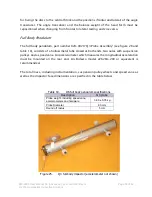
020-9905 User Manual Q3 (Advanced 3 year old child) Rev G Page 73 of 82
© 2016 Humanetics Innovative Solutions
Performing the test
1.
Attach honeycomb material to arrest the pendulum. Proposed is to use Hexcel (28.8
kg/m
3
) with crush strength of 1.8 lbs/cu.ft, with a nominal length of 76.2 mm (3
inches).
2.
Auto-balancing and shunt calibration of the transducer signals should be performed
with the pendulum arm in the vertical position.
3.
Lift the pendulum up to its pre-test height and check that the head is in the correct
initial position. Do not leave the head-spine system in this position for more than 1
minute, as the neck will start to deform due to the mass of the head form.
4.
Release the pendulum.
Data Processing
1.
Filter the pendulum acceleration at CFC180.
2.
Filter the potentiometer readings at CFC600.
3.
Determine time zero of the impact by finding the 1 g deceleration level in the
pendulum signal (after filtering).
4.
Software-zero all transducer readings by averaging the part of the signal before time
zero and subtracting this from the transducer reading.
5.
Integrate the pendulum acceleration to check the deceleration velocity of the
pendulum. The velocity of the arm must be calculated at a point 1657.4 mm from
the pendulum pivot point.
6.
Sum the potentiometer signals to derive the total head relative to pendulum arm
angle.
Requirements
1.
The impact velocity should be between 4.3 and 4.5 m/s.
2.
The pendulum velocity decrease should be as indicated in the table below:
Time ms
Lower limit m/s
Upper limit m/s
10
1.3
1.7
20
2.7
3.7
30
4.1
4.9
To meet the requirements of the frontal lumbar spine certification test:
3.
The maximum head angle (first maximum) should be between 40.0 and 50.0
degrees.
This value should occur between 42 and 62 ms from the time-zero point.
























